The Stellenbosch University Botanical Garden signed the International Agenda for Botanic Gardens in Conservation in 2013 and fully supports plant conservation by working towards the 16 targets set out by the Global Strategy for Plant Conservation (GSPC). SUBG is a Botanic Gardens Conservation International accredited Conservation Practitioner since 2018. The Garden is an active conservation practitioner and contributes to the conservation of species that are in real threat of extinction. The Garden also supports the work of other conservation practitioners and regularly collaborates with other organisations and individuals to contribute to species conservation and recovery. Much of our conservation work happens in partnership with and with support from other organisations and individuals. Here are some of our recent collaborators and funders that have contributed to making our conservation work more impactful.

Individuals include Rupert Koopman, Tristan Kruger, Professor Leanne Dreyer, Dr Kenneth Oberlander, Jannie Groenewald, Dr Brian du Preez.
Some of our most important conservation work happens behind the scenes and is not always visually impressive. But this work requires specialist knowledge, and maintaining high standards of collection management is time-consuming. Upcoming needs for our conservation work includes constructing a large insect-excluding enclosure to prevent hybridization and genetic deterioration of conservation collections, as well as genetic research to groundtruth our collection management protocols. If you would like to make a donation towards these upcoming projects or any other aspect of our conservation work, please follow this link.
Below are a few summaries of some of the conservation work done and supported by SUBG which has contributed to the conservation of threatened Cape species.
Haemanthus pumilio
SANBI Red List of South African Plants status: Critically Endangered
 This species belongs to the Amaryllidaceae family and is one of the “paintbrush lilies". It is flagship species for the threatened alluvial habitats of the Boland, which has in recent decades been mostly destroyed by agricultural and urban development. Only a few populations survive, all of which are vulnerable to further loss. One population is regularly monitored by SUBG staff, which has contributed to the recent uplisting of the species' threat status from Endangered to Critically Endangered.
This species belongs to the Amaryllidaceae family and is one of the “paintbrush lilies". It is flagship species for the threatened alluvial habitats of the Boland, which has in recent decades been mostly destroyed by agricultural and urban development. Only a few populations survive, all of which are vulnerable to further loss. One population is regularly monitored by SUBG staff, which has contributed to the recent uplisting of the species' threat status from Endangered to Critically Endangered.
Each autumn when the plants flower, SUBG staff visit the population regularly to make population counts, hand-pollinate flowering plants and collect seeds. Plants are hand-pollinated as seedset is very low otherwise, possibly due to lack of pollinators in this habitat fragment which is boxed in by housing developments. SUBG staff has to go the extra mile to protect the plants from herbivores by constructing small enclosures to cover each plant while it is producing seed. Haemanthus seed is recalcitrant, which means it can not dry out and therefore can't be stored like many other seeds. The collected seed is sown at SUBG each year to build the ex situ population and provide a backup for this species in dire need of conservation. In earlier years of propagating this species, propagation success rates were not very high. However, in 2020 the Curator of the Garden decided to experiment with growing the species in a specialist bonsai medium known as akadama, and subsequently SUBG has had high rates of propagation success.
Since 2014, SUBG has supported research projects, led by Dr Paul Hills at the Institute for Plant Biotechnology at Stellenbosch University, which has aimed to develop a micropropagation protocol for Haemanthus pumilio to contribute to its conservation and recovery.
Ixia versicolor
SANBI Red List of South African Plants status: Critically Endangered
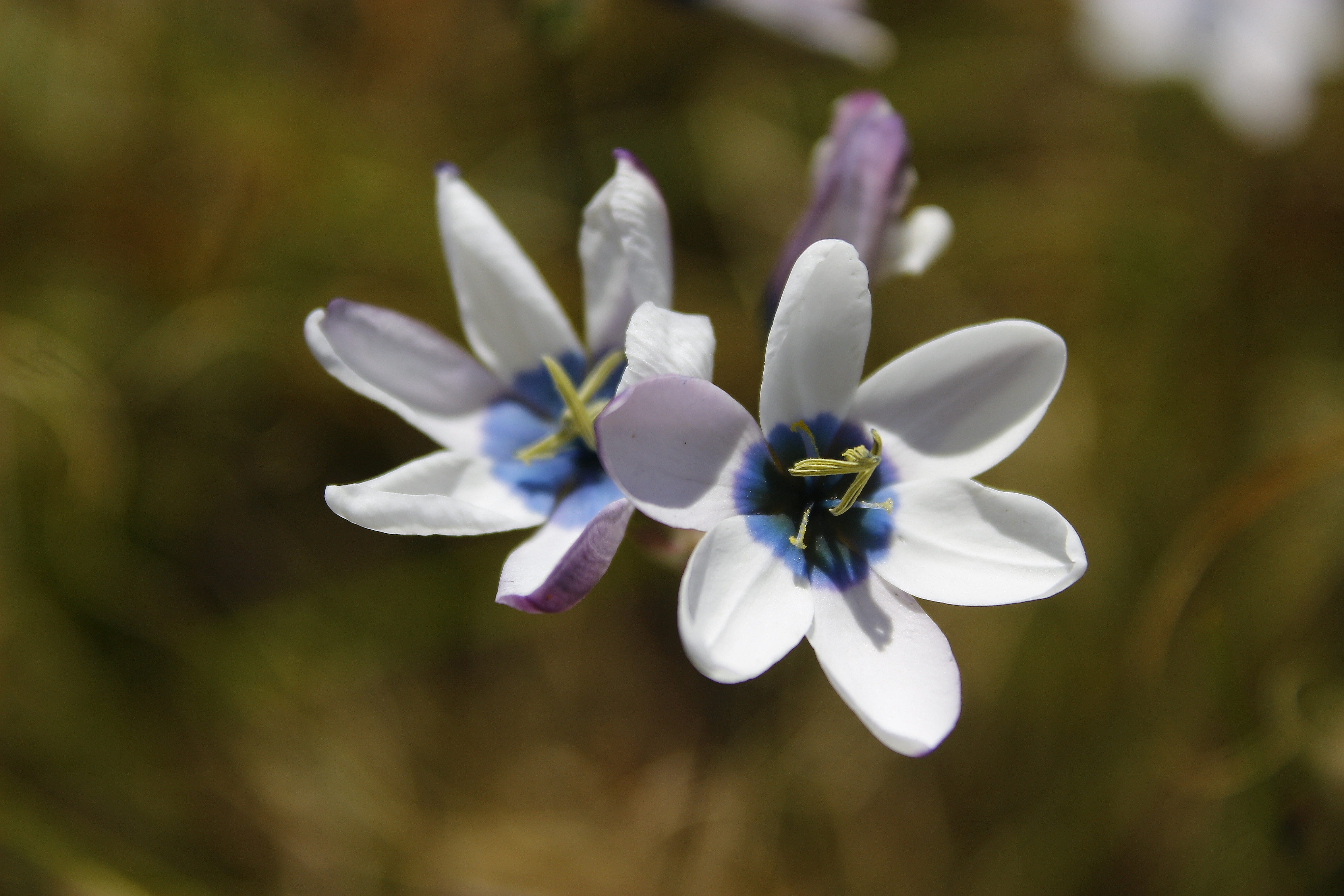 This is a range-restricted species that now only survives in two populations. The larger remaining population occurs in a partially protected reserve, while the other occurs in an urban park where it is subject to trampling, mowing and other disturbances. This second population is conserved in an ex situ collection at SUBG. Seed collected over multiple seasons has been banked and propagated to bulk up this threatened population and secure material for restoration and recovery of the species.
This is a range-restricted species that now only survives in two populations. The larger remaining population occurs in a partially protected reserve, while the other occurs in an urban park where it is subject to trampling, mowing and other disturbances. This second population is conserved in an ex situ collection at SUBG. Seed collected over multiple seasons has been banked and propagated to bulk up this threatened population and secure material for restoration and recovery of the species.
In 2023, a heavy vehicle drove into this urban park after heavy rains and caused severe damage to a section of the park. In collaboration with the Custodians of Rare and Endangered Wildflowers (CREW), SUBG staff visited the site after the incident to assess the damage and restore damaged sections of the park. Subsoil excavated by the vehicle was moved to more disturbed sections of the park, while topsoil was carefully leveled in more pristine sections of the park in case any bulbs, corms, or seeds survived in the soil. Although the damage caused by this incident was ultimately not disastrous for the population, it illustrates how quickly and unpredictably a threatened species can be impacted and highlights the importance of having ex situ material backed up in conservation collections. In cases of severe damage to this population, the plants and seeds in SUBG's collection can be used for restoration.


Oxalis fragilis
SANBI Red List of South African Plants status: Critically Endangered
This species was thought to be extinct as it had not been seen since 1936 despite multiple searches. In 2018, it was rediscovered by Rupert Koopman at a single site. The species has lost 90% of its habitat over the past century, and this loss still continues. This single known population was visited by SUBG curator Dr Donovan Kirkwood and South African Oxalis expert Prof Leanne Dreyer to collect plants for ex situ conservation at SUBG.
From these collected plants, the ex situ collection of this species has grown substantially at SUBG. Like most South African Oxalis species, the species has recalcitrant seeds, which means seeds can not dry out and therefore can not be seed banked. The easiest way to conserve these plants ex situ is to hold a living collection. Like most Oxalis, the species also has a specialised reproductive system known as tristyly. Tristyly promotes genetic diversity in populations and species by promoting outcrossing and preventing inbreeding. In 2022, this reproductive system was investigated in Oxalis fragilis in an honours research project by the current SUBG Assistant Curator, Annerie Senekal, under the supervision of Oxalis experts Professor Leanne Dreyer and Kenneth Oberlander. This project showed how the tristylous breeding system of this species is still functional. Extra data collected in the years following this project will shed light on how this system is inherited in Oxalis fragilis. This data is still in the process of analysis and will be published in the near future. Results from this study will help inform the long-term ex situ management of this species and help safeguard it against extinction.
A possible second population was discovered in 2024, but this is still being confirmed.
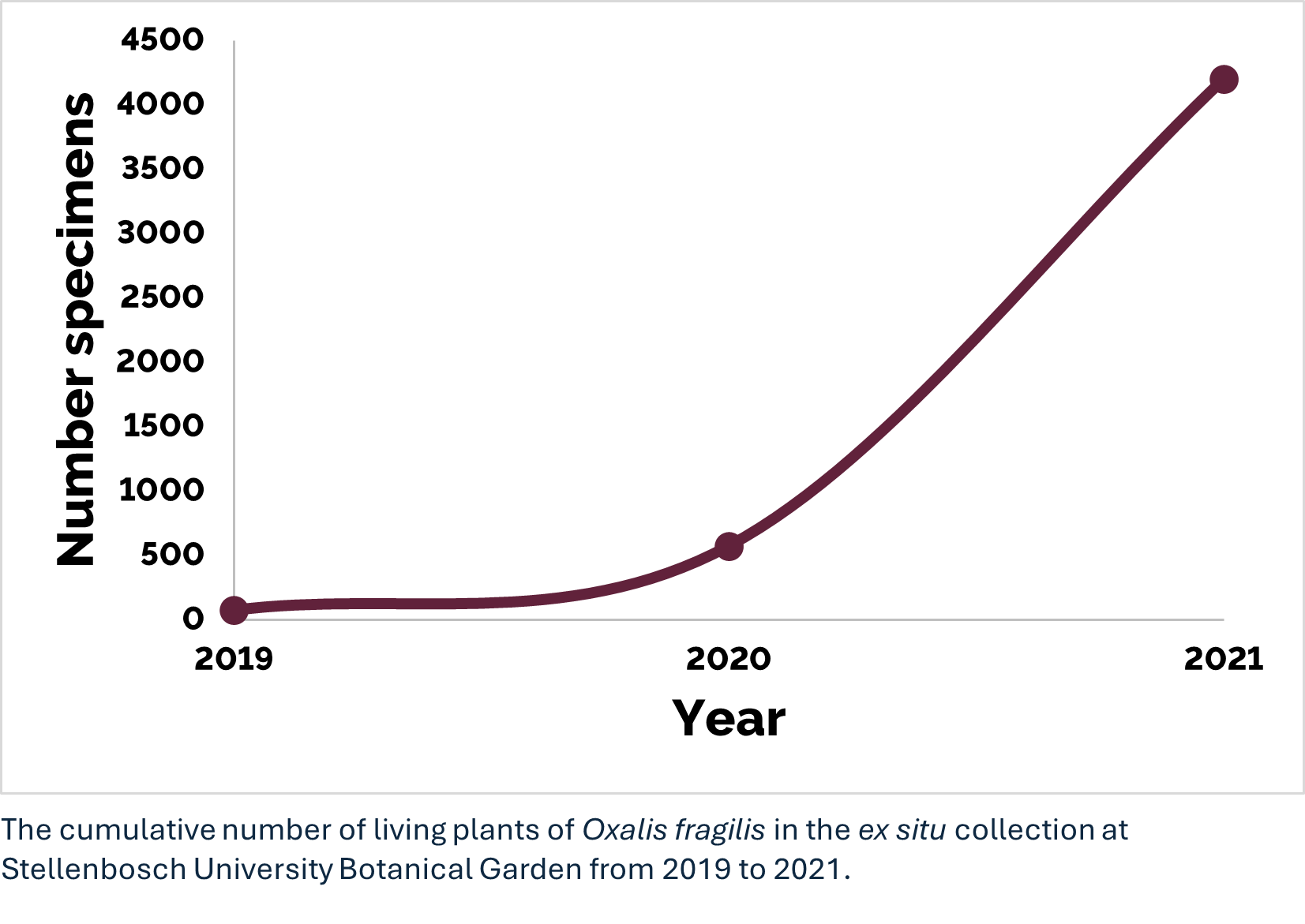
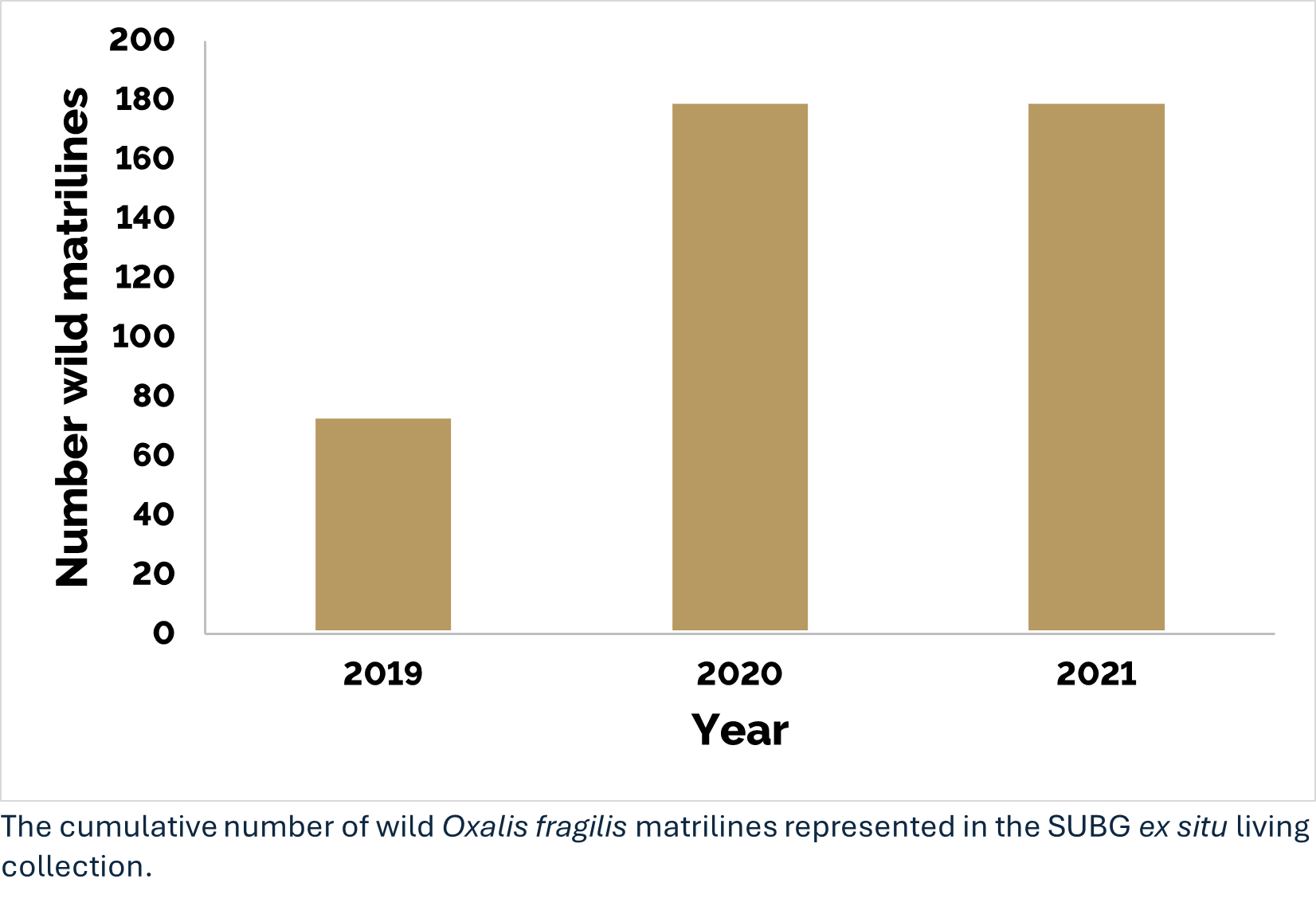
Pelargonium fergusoniae
SANBI Red List of South African Plants status: Endangered


This species only survives in a handful populations in the Overberg, where it grows in the lowlands. The Overberg lowlands are highly transformed due to agriculture, and less than 5% of natural habitats are still intact in the Overberg renosterveld. The Pelargonium fergusoniae plants in SUBG's collection comes from a previously unrecorded population on an unsecure site. From the original plants that were collected, SUBG is bulking up the seed collection to provide backup in case the population should be destroyed or degraded. Seed will be shared with other institutions like Millennium Seed Bank and partner botanical gardens to provide further backup – any collection can face unexpected crises, and if a disaster at SUBG leads to all seed being destroyed, there will be seed at other organisations to offset this problem.
In addition to being an important ex situ conservation collection, this species is also growing in our Cape Threatened Lowland Habitat display, funded by the Table Mountain Fund.
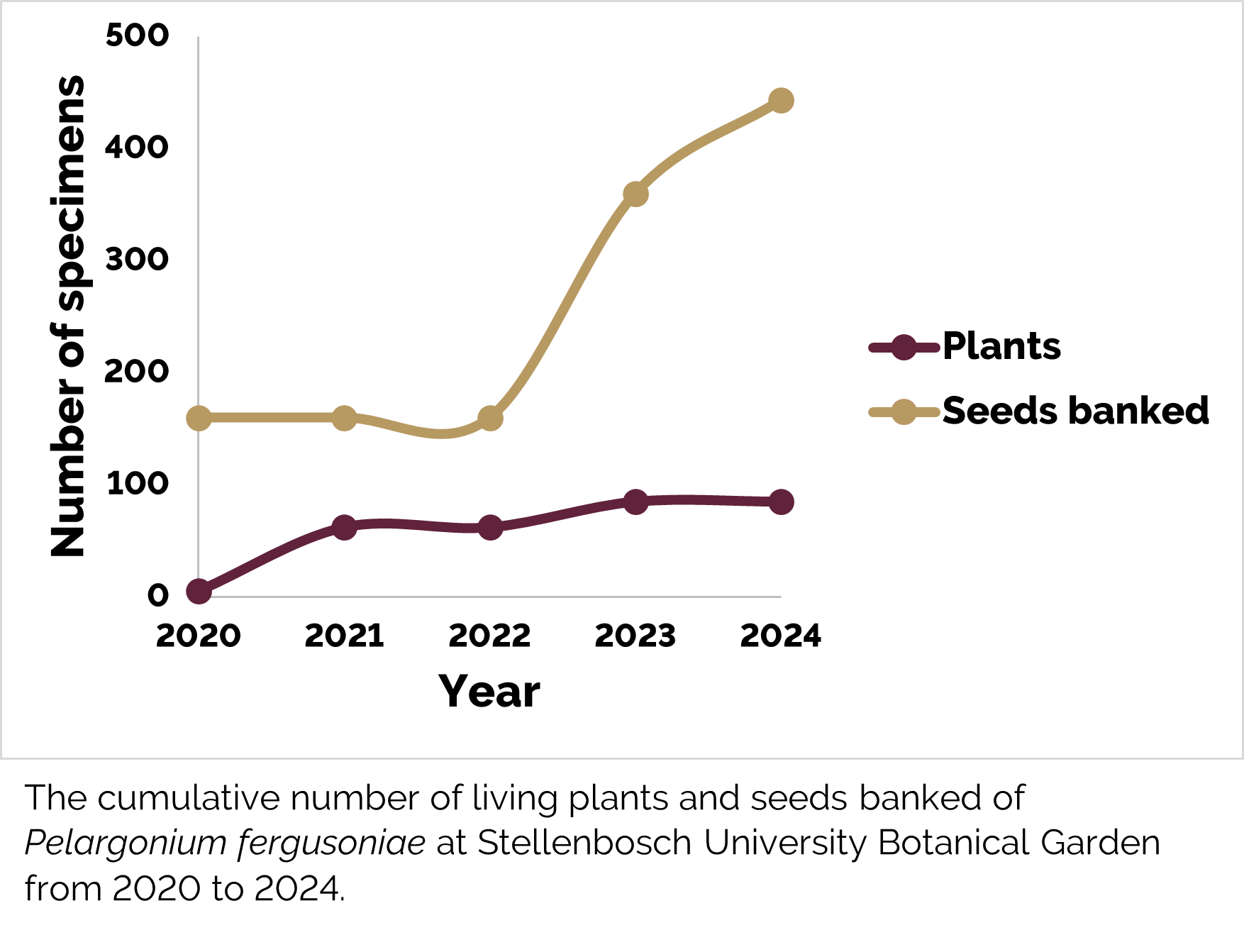
Marasmodes undulata
SANBI Red List of South African Plants status: Critically Endangered
There are only 13 species of Marasmodes, all of which are endemic to the Cape. Each of these species occur in lowland renosterveld or fynbos, and all are range-restricted and threatened. The Cape lowlands have suffered much habitat transformation, which has led to an increased threat status for many species. Marasmodes undulata was thought to be extinct for a long time, until it was rediscovered in the 1980s. The single population that it is known from survives in a small urban park surrounded by industria and housing. In the early 1980s, just under 500 plants were counted by CapeNature, which dropped to 200 in the early 1990s. The Custodians of Rare and Endangered Wildflowers (CREW) searched the site in 2005 and found only 19 plants. By 2020, only 3 plants were known to survive. CREW has been working to secure this last population of Marasmodes undulata by propagating the species from seeds and cuttings from subsequent seedlings. This project is supported by many organisations, including Kirstenbosch National Botanical Garden, the Millennium Seed Bank team at Kirstenbosch, the Drakenstein Municipality and Stellenbosch University Botanical Garden.
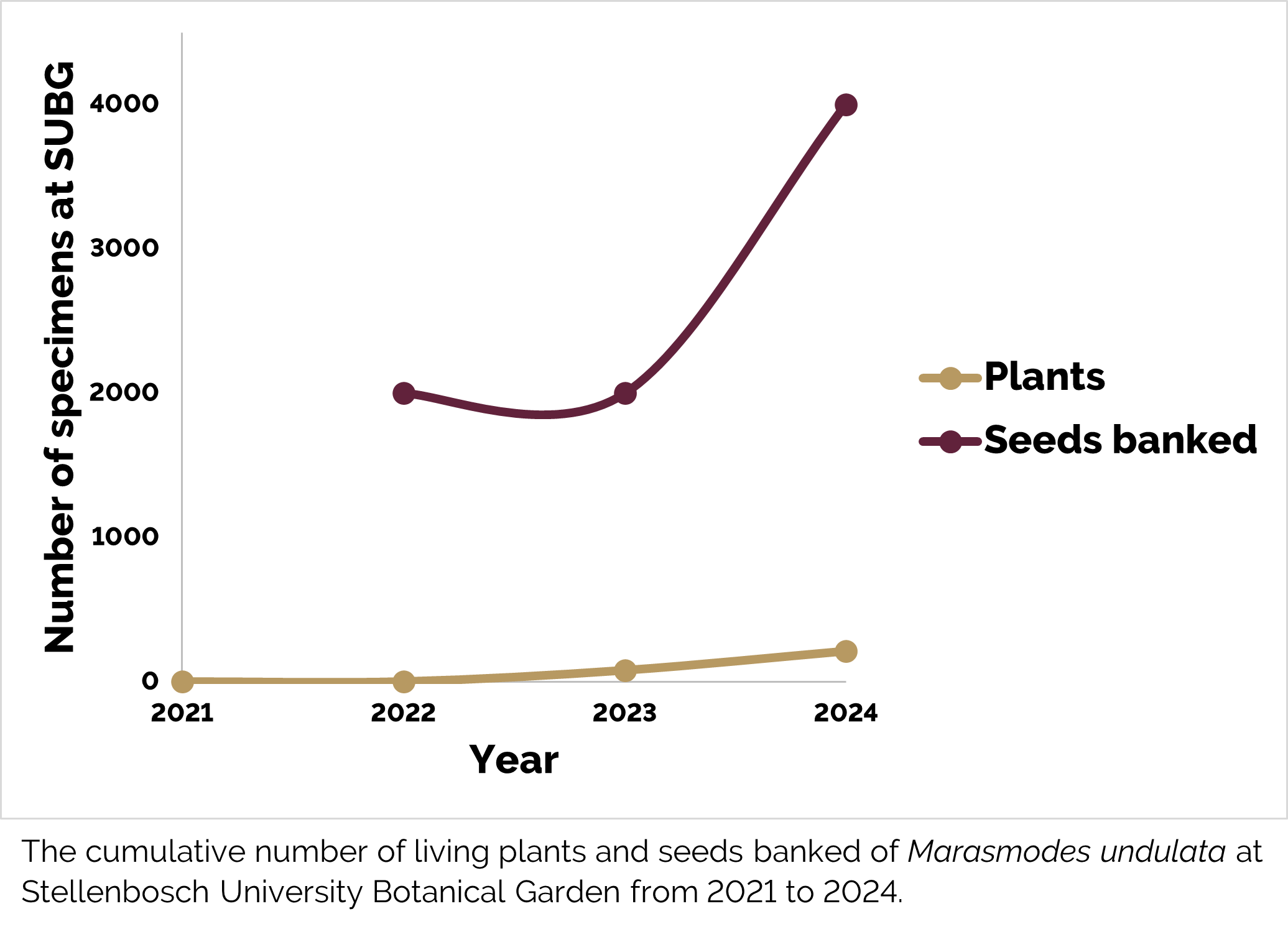 Since 2020, SUBG has propagated nearly 100 individuals of this species from seed and cuttings, and propagation from mature plants in the garden continues regularly. Some of these propagated plants have planted back into their habitat by CREW, and these restoration efforts will continue in coming years. SUBG has also seedbanked thousands of seeds, which are now securely backed up in multiple institutions, used to bulk up the ex situ population of this species and supporting a germination protocol research project.
Since 2020, SUBG has propagated nearly 100 individuals of this species from seed and cuttings, and propagation from mature plants in the garden continues regularly. Some of these propagated plants have planted back into their habitat by CREW, and these restoration efforts will continue in coming years. SUBG has also seedbanked thousands of seeds, which are now securely backed up in multiple institutions, used to bulk up the ex situ population of this species and supporting a germination protocol research project.
Polhillia groenewaldii
SANBI Red List of South African Plants status: Critically Endangered
 There are only four confirmed plants of this species in the wild. As at July 2024, Stellenbosch University Botanical Garden is the only organisation that holds an ex situ collection of this species as far as we are aware. Some plants have been grown from seed, and a small seed collection also exists in our seed bank. This seed will be grown and distributed to key conservation partners and used for eventual wild species recovery.
There are only four confirmed plants of this species in the wild. As at July 2024, Stellenbosch University Botanical Garden is the only organisation that holds an ex situ collection of this species as far as we are aware. Some plants have been grown from seed, and a small seed collection also exists in our seed bank. This seed will be grown and distributed to key conservation partners and used for eventual wild species recovery.
This species is highly localized and is known only from a single site near Barrydale. It was discovered by and named after an ex-intern of Stellenbosch University Botanical Garden, Jannie Groenewald. The confirmation that this was a new species and formal species description was done by Dr Brian du Preez while he was busy with his MSc at Stellenbosch University.
Gibbaeum esterhuyseniae
SANBI Red List of South African Plants status: Critically Endangered
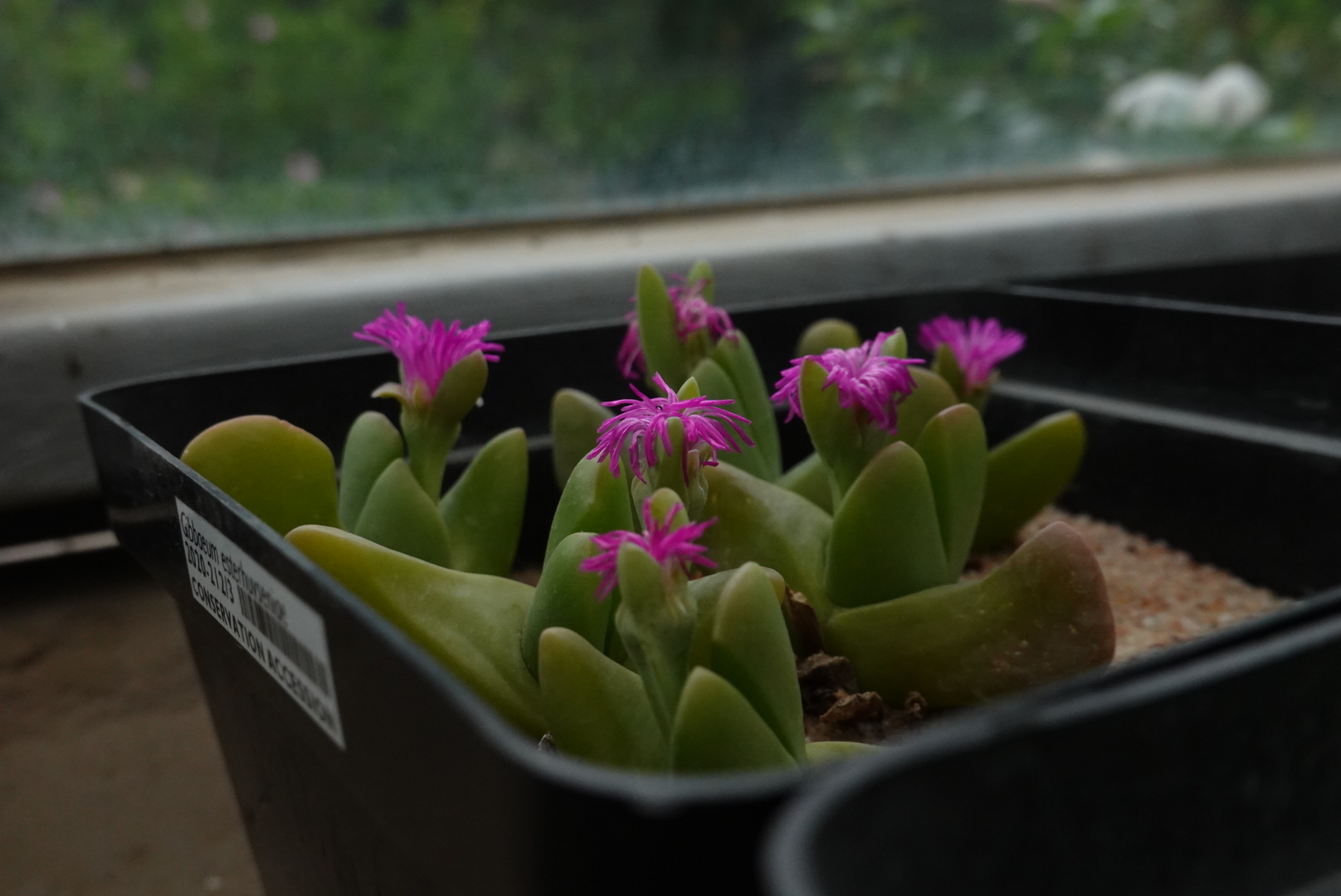
Historically, this Klein Karoo species occurred from Bonnievale to McGregor, but is now only known from an area of less than 10km2. Much of its habitat has been lost to agriculture. The only remaining population is under threat because of porcupines that eat dig up and eat the plants. In 2020 field biologists discovered all three subpopulations decimated by porcupine herbivory, and rescued uprooted plant pieces were brought to SUBG to attempt re-rooting as cuttings and to harvest seed. Stellenbosch University Botanical Garden now holds a collection of plants and seeds from this last remaining population as a ex situ conservation collection that can be used for reintroduction in the future. Annual hand-pollinations and seed collection takes place to bulk up the seed bank for this species and this will be distributed to key conservation partners.
Ixia leipoldtii
SANBI Red List of South African Plants status: Critically Endangered
This species was collected for the first time in 1935 by South African poet C. L. Leipoldt, who was a keen botanist. After this initial encounter, the species was not seen for another 42 years, when John Manning chanced upon a small population of this species. After this sighting, the species was not recorded again by anyone until Keir and Alouise Lynch, who operate as a field survey and biodiversity management operation called Bionerds, found a population after 2 years of searching for this species. They surveyed this last known locality and found about 70 plants, possibly all that remains in the wild. Seed was collected and distributed to conservation partners for ex situ conservation, including to SUBG. Plants from this seed is now growing at SUBG and annual hand-pollination and pollinator exclusion helps to increase the ex situ seed bank while protecting the species from hybridising with other species in the garden.
Gladiolus recurvus
SANBI Red List of South African Plants status: Critically Endangered

Although this species is considered much less threatened than many of our other conservation priority species, SUBG holds plants and seeds of populations that are either extinct in the wild or in dire threat.
This species is endemic to the Cape lowlands, which has been severely transformed and degraded over the past century. Habitat loss in the lowlands continue as urban development and agricultural expansion continues. In 2021, SUBG took part in a search-and-rescue operation to collect plants and seeds from a site that was earmarked for development in the coming months. Many hours were spent carefully removing all plants* we could find and taking special care to find and collect threatened species. Gladiolus recurvus was one of several threatened species found at this site. All the plants and seeds that could be found were collected, and are now growing at SUBG. This collection is a valuable genetic backup of this now extinct population that contributes to the conservation of this species overall.
 *Note: SUBG does not generally remove mature plants from their habitat. Conservation collection is done with non-destructive sampling, which includes collecting seeds and cuttings according to best practice guidelines and as specified by our collection permits. However, during search-and-rescue operations all plants are removed as the site will be destroyed and plants lost if not collected for ex situ conservation or restoration.
*Note: SUBG does not generally remove mature plants from their habitat. Conservation collection is done with non-destructive sampling, which includes collecting seeds and cuttings according to best practice guidelines and as specified by our collection permits. However, during search-and-rescue operations all plants are removed as the site will be destroyed and plants lost if not collected for ex situ conservation or restoration.


